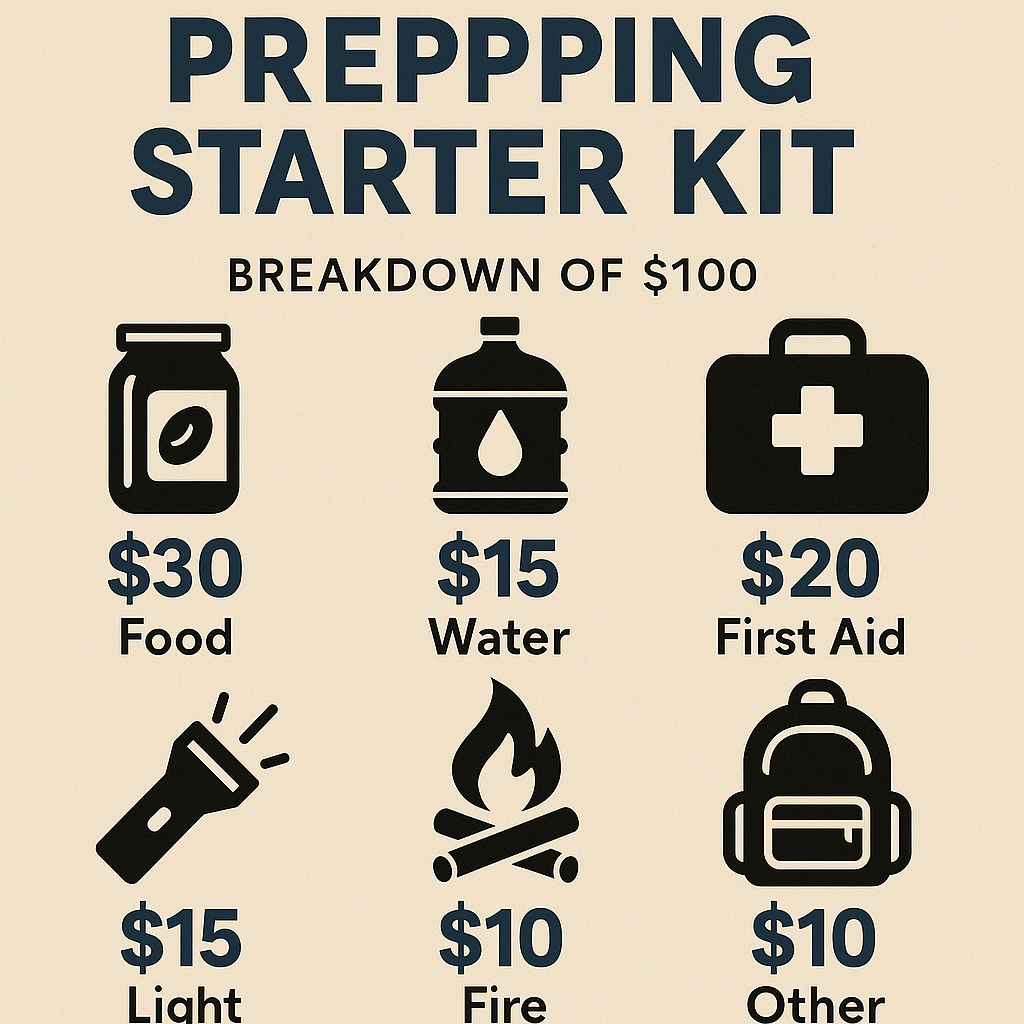How to Start Prepping on a Tight Budget (Under $100)
 In today’s uncertain world, the desire to become more self-reliant is stronger than ever. However, many beginners mistakenly believe that prepping requires a massive financial investment. The truth is, you can start prepping on a tight budget (under $100) and still make meaningful progress toward securing your future. In this guide, we’ll show you exactly how to get started, step-by-step, without draining your wallet.
In today’s uncertain world, the desire to become more self-reliant is stronger than ever. However, many beginners mistakenly believe that prepping requires a massive financial investment. The truth is, you can start prepping on a tight budget (under $100) and still make meaningful progress toward securing your future. In this guide, we’ll show you exactly how to get started, step-by-step, without draining your wallet.
Why Prepping on a Budget Matters
Prepping is not just for the wealthy or the extreme survivalists. Anyone can (and should) start building resilience, regardless of income.
Starting small helps you prioritize what’s truly essential and avoid wasting money on gimmicky gear. Additionally, prepping on a budget fosters creativity, resourcefulness, and critical thinking — traits crucial for true survival.
Tip: Start with what you already have. Inventory your supplies before buying anything new.
Step 1: Set Clear Priorities for Your First $100
 When beginning your prepping journey, every dollar matters. Therefore, it’s critical to focus on the basics first: water, food, shelter, and security.
When beginning your prepping journey, every dollar matters. Therefore, it’s critical to focus on the basics first: water, food, shelter, and security.
Here’s a suggested budget breakdown:
- Water: $10
- Food: $30
- Shelter/Protection: $30
- Basic Tools and Supplies: $30
You can adjust these allocations slightly based on your personal needs and risks.
Step 2: Focus on Water First
 Access to clean drinking water is non-negotiable for survival. Fortunately, prepping for water needs doesn’t have to be expensive.
Access to clean drinking water is non-negotiable for survival. Fortunately, prepping for water needs doesn’t have to be expensive.
Smart Water Prep Ideas:
- Buy a life straw or affordable personal water filter (~$20).
- Store tap water in free or low-cost containers (reuse 2-liter soda bottles).
- Add unscented bleach (~$5) to your kit for water purification.
Water Storage Tips for Preppers
Step 3: Build a Low-Cost Food Reserve
Food security is next on your list. For less than $30, you can begin a small but meaningful food stockpile.
Recommended Items:
- Rice (5 lbs) — $4
- Dry beans (4 lbs) — $5
- Peanut butter (16 oz) — $3
- Canned vegetables (5 cans) — $5
- Canned tuna or chicken (4 cans) — $5
- Oatmeal (large container) — $4
- Ramen noodles (6-pack) — $2
- Salt, pepper, basic spices — $2
Focus on non-perishable, calorie-dense foods. Over time, expand your food storage based on your budget.
Tip: Always rotate your stockpile to prevent spoilage.
Best Foods for Long-Term Survival Storage
Step 4: Shelter and Personal Protection Essentials
In an emergency, staying warm, dry, and protected is critical. You don’t need to spend a fortune to cover these bases.
Smart Shelter Prep for Under $30:
- Mylar emergency blankets (pack of 4) — ~$10
- Plastic tarp and paracord — ~$10
- Rain poncho — ~$5
- Wool socks (thermal) — ~$5
If you have extra budget, consider a simple bivy sack or inexpensive sleeping bag.
Security Tip:
For self-defense, focus first on awareness and avoidance. Basic tools like pepper spray (~$10) can also fit within a small budget.
Step 5: Basic Tools and Multipurpose Gear
Versatile, multi-use tools are a prepper’s best friend, especially when funds are tight.
Must-Have Budget Items:
- Multi-tool (budget model) — ~$20
- LED flashlight (battery operated) — ~$5
- Extra batteries — ~$5
- Duct tape — ~$5
These items can fix gear, build shelter, provide light, and support dozens of survival tasks.
Tip: Look for quality used tools at thrift stores, yard sales, or online marketplaces.
Step 6: Bonus: Free or Low-Cost Skills That Save Lives
Knowledge is free — and often more valuable than gear. While building your supplies, invest time in learning:
- Basic first aid
- Fire starting techniques
- Water purification methods
- How to build a simple shelter
YouTube channels, free online courses, and local community centers often provide free survival training resources.
Top 10 Survival Skills Everyone Should Know
Example Budget Kit for Preppers Under $100
Here’s a sample starter kit for prepping under $100:
| Item | Estimated Cost |
|---|---|
| Personal Water Filter | $20 |
| Bleach (for disinfection) | $5 |
| Food Staples (rice, beans, etc.) | $30 |
| Emergency Blanket Set | $10 |
| Tarp & Paracord Set | $10 |
| Multi-tool | $20 |
| Flashlight + Batteries | $5 |
| Total | $100 |
Where to Save Even More
- Dollar stores often carry batteries, canned foods, and first aid items.
- Thrift stores are goldmines for tarps, clothing, and camping gear.
- Online marketplaces like Facebook Marketplace or Craigslist offer cheap survival gear bundles.
- Local government emergency programs sometimes offer free preparedness workshops and supplies.
Final Thoughts: Start Small, Stay Consistent
Starting your prepping journey on a tight budget (under $100) is not only possible — it’s smart. By focusing on essentials, being resourceful, and building your skills, you will create a strong foundation for greater self-reliance over time.
Remember: Prepping is a lifestyle, not a one-time event. Start where you are, use what you have, and improve as you go.
Ready to dive deeper into survival prepping?
👉 Explore our full beginner’s prepping guide here!
👉 Check out affordable gear recommendations!
Stay prepared, stay resilient — no matter your budget.